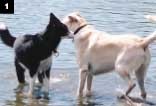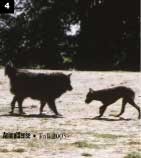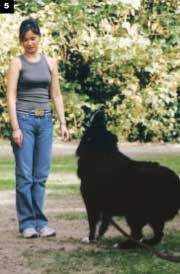Interacting Safely With Dogs
You are walking through your neighborhood on your way home. A large dog
you do not recognize walks toward you. You glance around, but cannot see
the guardian. Uncertain of the dog and his intentions, what should you
do next?
People
spend a lot of time outdoors and interactions with other people and
animals are common. The downside is that occasionally people are bitten
by the dogs they encounter. While generally most bites are by dogs known
to the victim (their own dog or a neighbor's), serious dogs bites can
also be inflicted in public places on victims who did not know the dog.
In many
cases, victim behavior is thought to contribute to the risk of being
bitten. We can reduce this risk by adapting our own behavior and
subsequently appeasing an approaching dog if we understand firstly, its
emotional state and secondly, how the dog will interpret our actions.
Body postures, facial expressions, ear and tail positions, movement and
vocalizations can reveal what a dog is thinking.
Why do
dog bites occur?
Researchers have investigated the reasons why guardians of
aggressive dogs believed their dogs had bitten. The most common reason
was dominance; the dog felt challenged in some way by its victim.
Further reasons were because the dog was overexcited during play,
because the dog was fearful and felt threatened, because the dog was ill
and possibly in pain and because the dog wanted to protect its guardian.
More specific to being outdoors, people get bitten as they run,
skateboard or cycle away from dogs in large open spaces. This type of
movement may trigger a chase response that arises from canine predatory
instincts and can climax in a nip to the fleeing target. It is rare for
a dog to bite for no apparent reason.
How to
behave when encountering a dog
While fewer than 10 per cent of dog bites receive medical attention, the
frequency and intensity of dog bites can be reduced if we understand how
to interact with dogs. Signals used between dogs also provide insights
into their characters as they encounter people.
Some dogs are difficult to read, particularly if they have had their
communication mechanisms altered (e.g., docked tails, cropped ears, long
curly coats that obscure eye and ear positions). An unfamiliar dog is an
unpredictable dog and so vigilance is necessary. Never put your face
near to any dog you meet, no matter how friendly he appears.
 A relaxed
greeting (Photo 1) A relaxed
greeting (Photo 1)
Certain ritualistic behaviors are displayed when dogs meet. A typical
greeting consists of sniffing the other dog’s anal glands, which produce
pheromones indicating each dog’s identity. If both dogs are relaxed,
they will have a relaxed body posture, as revealed by their ear, tail,
body and facial expressions. This type of greeting can readily escalate
into play.
 A fearful
greeting (Photo 2) A fearful
greeting (Photo 2)
Some dogs are fearful of other dogs and prefer not to be approached.
They indicate this by moving away from the other dog. However, sometimes
they may be tethered or cornered and unable to escape their advances.
Fearfulness is exhibited through a low posture, trembling and avoidance.
Fearfulness may escalate into aggression if the advances continue.
 A dominant
greeting (Photo 3) A dominant
greeting (Photo 3)
Often one dog will assume the higher status as dogs meet. This is
communicated through a high posture, where the dog makes itself look
larger by stiffening its legs, holding its head, ears and tail up (the
tail may even wag) and perhaps raising its hackles. It will also stare
at the second dog. This can escalate into aggression if the second dog
responds in the same way.
A submissive greeting (Photo 4)
 Alternately,
the second dog can appease the dominant dog through submissive gestures,
referred to as calming signals. Adopting a low posture when approaching
(staying quiet and calm, head lowered, tail tucked low), orienting
sideways, muzzle licking, avoiding eye contact and blinking indicates
that this dog is not a threat to the first dog. The first dog is
generally calmed by this behavior as his higher status is acknowledged. Alternately,
the second dog can appease the dominant dog through submissive gestures,
referred to as calming signals. Adopting a low posture when approaching
(staying quiet and calm, head lowered, tail tucked low), orienting
sideways, muzzle licking, avoiding eye contact and blinking indicates
that this dog is not a threat to the first dog. The first dog is
generally calmed by this behavior as his higher status is acknowledged.
Dealing
with aggressive canines
If you encounter a dog who appears threatening or of which you are
uncertain:
1. Keep
your distance – This instantly minimizes your chances of being
bitten. Even dogs that appear to be tethered may be on long lines or not
attached to anything.
 2. Remain
calm, quiet and still if the dog approaches you – Do not scream,
shout, run away, make rapid jerky movements or stare at the dog. Keep
your arms by your side — adopt the strategy of a submissive dog — see
photo 5. Wait for the dog to lose interest unless it makes friendly or
submissive advances. Otherwise, back away slowly. 2. Remain
calm, quiet and still if the dog approaches you – Do not scream,
shout, run away, make rapid jerky movements or stare at the dog. Keep
your arms by your side — adopt the strategy of a submissive dog — see
photo 5. Wait for the dog to lose interest unless it makes friendly or
submissive advances. Otherwise, back away slowly.
3.
Remain calm if the dog lunges at you – Give the dog something to
bite such as a purse, backpack or newspaper. If you are knocked over,
lie on your stomach or curl into the fetal position, keeping your head
tucked and your arms folded over your neck and head — see photo 6.

4. If
you are bitten seek medical attention – Inform Animal Control, the
local health authority or the SPCA of the situation if the dog was a
stray. Contact the guardians (if you can find them) to inform them of
their dog’s action.
How to
be a responsible guardian
Do:
-
Keep your
dog under control at all times in public places – you may be fined and
found negligent if your dog causes a disturbance to others;
-
Muzzle
your dog in public places if your dog’s behavior is unpredictably
aggressive;
-
Warn
people not to approach your dog if you think he may feel threatened or
challenged;
-
Inform
people how to interact with your dog. Tell them to be calm and gentle
and to avoid crowding him. Demonstrate how he likes to be touched;
-
Avoid
situations where your dog is able to chase children, cyclists and
joggers;
-
Seek
advice from your veterinarian or dog trainer to address your dog’s
behavior problems. The sooner you address the problem, the easier it
will be to manage it appropriately.
Do Not:
-
Allow
your dog to stray;
-
Tether
your dog so that he is vulnerable to intimidation by people or other
dogs;
-
Allow
unfamiliar or irresponsible children to approach or handle your dog;
-
Encourage
your dog to chase people or other animals.
|
